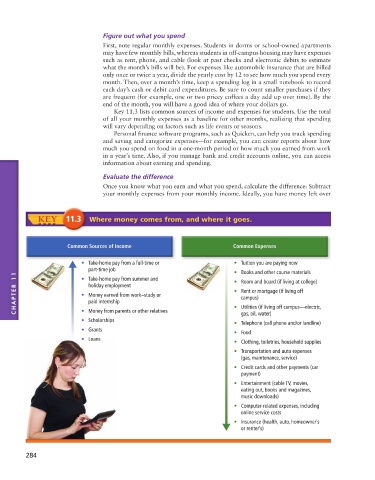Page 321 - Keys to College Success
P. 321
Figure out what you spend
First, note regular monthly expenses. Students in dorms or school-owned apartments
may have few monthly bills, whereas students in off-campus housing may have expenses
such as rent, phone, and cable (look at past checks and electronic debits to estimate
what the month’s bills will be). For expenses like automobile insurance that are billed
only once or twice a year, divide the yearly cost by 12 to see how much you spend every
month. Then, over a month’s time, keep a spending log in a small notebook to record
each day’s cash or debit card expenditures. Be sure to count smaller purchases if they
are frequent (for example, one or two pricey coffees a day add up over time). By the
end of the month, you will have a good idea of where your dollars go.
Key 11.3 lists common sources of income and expenses for students. Use the total
of all your monthly expenses as a baseline for other months, realizing that spending
will vary depending on factors such as life events or seasons.
Personal finance software programs, such as Quicken, can help you track spending
and saving and categorize expenses—for example, you can create reports about how
much you spend on food in a one-month period or how much you earned from work
in a year’s time. Also, if you manage bank and credit accounts online, you can access
information about earning and spending.
Evaluate the difference
Once you know what you earn and what you spend, calculate the difference: Subtract
your monthly expenses from your monthly income. Ideally, you have money left over
KEY 11.3 Where money comes from, and where it goes.
Common Sources of Income Common Expenses
• Take-home pay from a full-time or • Tuition you are paying now
part-time job • Books and other course materials
11 • Take-home pay from summer and • Room and board (if living at college)
CHAPTER • Money earned from work–study or • Rent or mortgage (if living off
holiday employment
campus)
paid internship
• Utilities (if living off campus—electric,
• Money from parents or other relatives
• Scholarships gas, oil, water)
• Telephone (cell phone and/or landline)
• Grants • Food
• Loans • Clothing, toiletries, household supplies
• Transportation and auto expenses
(gas, maintenance, service)
• Credit cards and other payments (car
payment)
• Entertainment (cable TV, movies,
eating out, books and magazines,
music downloads)
• Computer-related expenses, including
online service costs
• Insurance (health, auto, homeowner’s
or renter’s)
284

